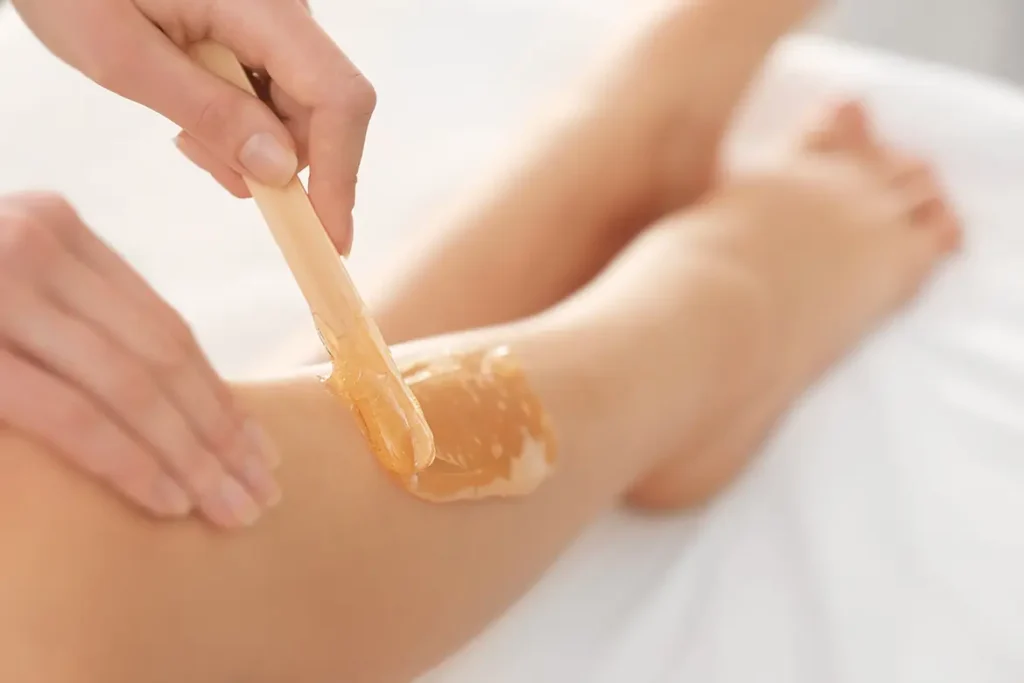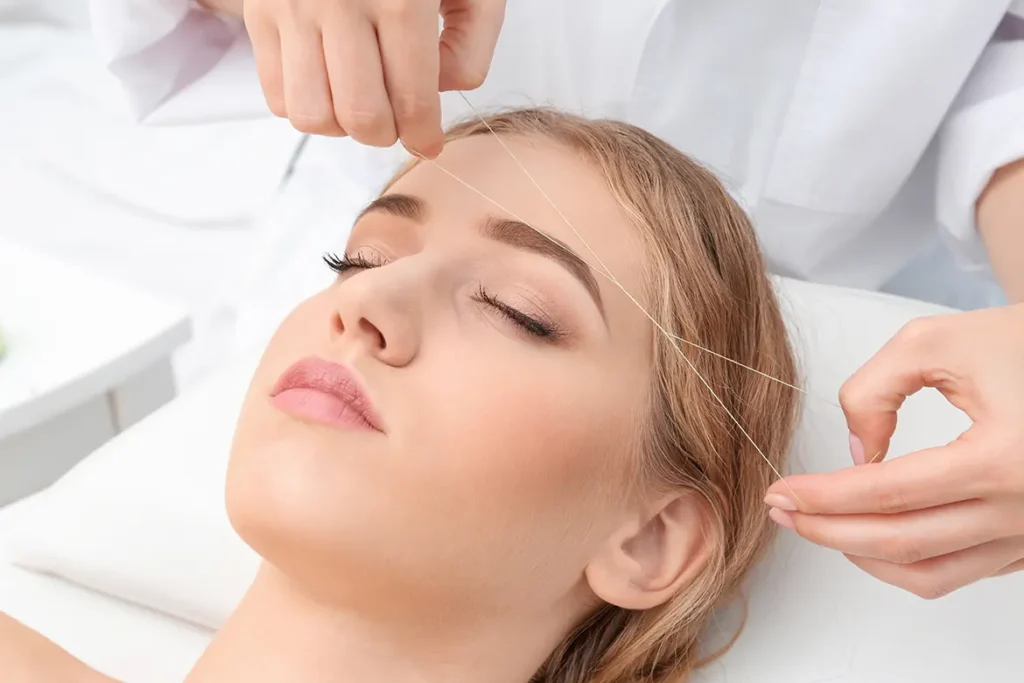It’s challenging to find a method of epilation or depilation that doesn’t significantly harm the skin while effectively removing hair. That’s why we’ve gathered the most effective methods of body hair removal recommended by dermatologists. You will learn:
- What are their features, pros, and cons?
- Which skin types and body areas are suitable for each method?
- How long does the effect last after the procedures?
Shaving

Painlessness
Compared to tweezing or waxing, where hair roots are removed, shaving does not cause discomfort.
Speed
The procedure can be done at home without special preparation. It takes between 10 to 20 minutes.
Short-term Results
Since the hair is cut at skin level rather than being removed from the root, it grows back quickly.
Risk of Irritation
There is a chance of irritation, itching, and ingrown hairs.
Not Recommended for Dense Black Hair Removal
After shaving, the tips of dense black hairs remain visible.
Not Suitable for Frequent Use
Regular shaving can lead to irritation, pimples, and breakouts.
- Steam your skin in warm water for a few minutes before shaving.
- Use new, sharp razor blades. Dull blades can cause irritation and leave cuts.
- Use shaving gels or creams.
- Shave against the direction of hair growth. In sensitive areas, shave with the direction of hair growth.
- After shaving, apply a soothing lotion or cream to your skin.
Plucking
Hair removal on the body through plucking is a method in which hairs are individually removed from the follicle using tweezers or a mechanical device that grabs multiple hairs at once, such as an epilator. It is suitable for normal, dry, and oily skin but not recommended for sensitive skin, as it may cause significant discomfort and irritation.
This method does not require steaming the skin or applying special products. With regular plucking, hairs become thinner and less dense. The results last up to 1-2 weeks.

Long-lasting Results
Hair is removed from the follicle, and the results of plucking last longer than shaving.
Root Removal
Reduces the risk of ingrown hairs.
Suitable for All Hair Types
The method is effective for removing dark and coarse hair, unlike shaving.
Painfulness
The method can be painful, especially when plucking on sensitive areas of the skin.
Time-Consuming
Plucking large areas with tweezers can take 1-2 hours. An epilator is faster, taking about 15-20 minutes.
Risk of Irritation
Plucking against the direction of hair growth or using non-sterile tools can lead to irritation.
Chemical Depilation
Chemical depilation is the removal of body hair using creams, lotions, or sprays that contain thiolactic or thiomilch acids. These substances break down the hair shaft. After the action of the chemical compounds, the hair can be easily wiped off the skin’s surface with a damp towel. Suitable for all skin and hair types. The results last for approximately 2 weeks.
Before the procedure, it is necessary to treat the area with an antiseptic and powder it with talcum. The hair that regrows after depilation becomes softer and finer.
Long-lasting Results
The effect of depilation lasts longer than shaving. Chemical agents also slow down hair growth.
Painlessness
Depilation does not cause discomfort.
Convenience
Depilation with creams or lotions is relatively simple. The procedure can be done at home.
Risk of Irritation
Chemical compounds may cause skin irritation or allergic reactions.
It is necessary to conduct a skin reaction test before the procedure. Chemical substances in depilatory products can be too aggressive, causing peeling or eruptions. Therefore, it is recommended to perform a test on a small skin area to prevent possible allergic reactions or irritation.
- Apply a few drops of the product to a small skin area.
- Rinse off at the specified time in the instructions or at the first signs of burning or tingling.
- If you do not experience a skin reaction within 24 hours after applying the product, it can be used.
- Do not use in case of burning or tingling.
Hot Wax Hair Removal
Waxing is a method in which hot wax (up to 50-60 degrees Celsius) is thinly applied to the skin and adheres to the hair. A cotton or cloth strip is then placed over the wax and quickly removed against the direction of hair growth. The results last for approximately 3-4 weeks.
There are no restrictions based on skin type. However, for individuals with sensitive skin, waxing may be more painful compared to others.

Long-lasting Results Compared to Shaving
Waxing removes hair from the follicles rather than just trimming them on the skin surface.
Clean Results
Hot wax captures even short hairs (5 to 10 mm) and removes them from the root.
Speed
The procedure takes 15-20 minutes.
Painfulness
The depilation process causes discomfort, especially during the first use or on more sensitive areas of the skin.
There is a chance of injuring the top layer of the skin during hair removal. The depilation process causes discomfort, especially during the first use or on more sensitive areas of the skin.
Risk of Allergy to Wax Components
Sugaring (Sugar Depilation)
Sugaring involves applying a thick paste made from sugar, lemon juice, and water to clean, dry skin. Using cloth strips, the mixture is removed along with the hair in the direction of their growth.
Sugaring is suitable for all skin types, especially sensitive skin, as it is less painful than waxing. The paste contains moisturizing components. The results last for approximately 3-4 weeks.

Natural Ingredients
Compared to chemical methods, the likelihood of allergies with sugaring is lower.
Gentleness of the Procedure
Sugaring paste has a soft texture, reducing the risk of skin damage and hair breakage.
Long-lasting Results
Hair is removed from the follicles, not just trimmed on the skin surface. Regrowth is much finer compared to using an epilator or tweezers.
Absence of Ingrown Hairs
Thanks to removal in the direction of hair growth.
Time-Consuming
The process takes from 30 minutes (bikini area) to 50 minutes (legs).
Discomfort
Painful sensations may occur, especially if the procedure is done for the first time or on sensitive skin areas.
Requirement for Specific Hair Length
At least 10 mm for proper paste adherence.
Threading

Suitable for Sensitive Skin
Threading does not involve the use of chemical products or cutting tools, making it suitable for sensitive skin.
Speed
It takes only 10 minutes to remove fine hair above the upper lip and shape eyebrows.
Safety
Ingrown hairs are eliminated when the technique is correctly executed.
Long-lasting Results
Hair is removed from the follicle.
Painfulness
Discomfort is possible, especially during the first procedure.
Risk of Skin Injury
Improper threading on thin skin may result in bruising.
Laser Hair Removal
Laser Hair Removal is a method of destroying the hair follicle by precisely burning the melanin pigment in the hair shaft using a laser. The effect of laser hair removal can be permanent, but sometimes the procedure may need to be repeated (depending on individual characteristics).
There are no restrictions based on skin type, but there are restrictions based on hair color. It is suitable for individuals with dark hair and light skin, as lasers better “see” the hair pigment. It is not suitable for removing light-colored hair because they have less melanin, and the laser does not react to them. It is also not suitable for dark skin with dark hair, as the laser cannot distinguish between the skin and the hair, posing a risk of burns.
Contraindications include vitiligo, pregnancy, and breastfeeding.

Long-term Results
Laser hair removal ensures hair removal in the treated area for 5-8 years.
Skin Safety
Cooling systems in lasers reduce the risk of burns during the procedure.
Painfulness
Discomfort is possible, especially on more sensitive areas of the skin.
Recommendations
Do not sunbathe for 10 days before the Laser Hair Removal session. The laser can cause irritation and leave burns on tanned skin.
On the day of the procedure, shave the area of the skin that needs to be treated.
For 5 days, avoid using deodorants (if hair removal was done in the armpit area). They contain components that block sweat glands and irritate the skin.
For 5 days, avoid hot baths (you can take a cool shower), workouts, and massages. Steaming the skin increases the healing time.
Electrolysis

Permanent Effect
Hair stops growing in the treated areas.
Time-Consuming
Several visits may be required. Electrolysis involves treating each hair individually. It takes 5-10 hours for the area above the upper lip and 8-16 hours for the bikini line.
Risks and Complications
Pigmentation and burns are possible.
Lengthy Healing
Complete healing may take more than 18 months.
- Apply cold compresses for 1-2 days.
- Use sun protection for 15 days.
- Apply aloe vera gel to the treated area for 20 days.
- Use antibacterial cream for 3 weeks.
- Avoid hot baths, touching, and combing the treated area, and refrain from applying makeup for 48 hours.
Vaniqa
Vaniqa is a cream containing eflornithine that targets the keratin protein. The medication slows down hair growth on the face and neck. It is intended only for women with hirsutism (excessive facial hair growth, such as on the upper lip and chin due to elevated levels of male hormones). It is contraindicated for men, girls under 12 years old, pregnant women, and breastfeeding mothers.
Vaniqa is not a standalone method. It is used in combination with other hair removal procedures (e.g., threading or waxing). The cream does not destroy follicles but makes the hair finer and softer.
Before applying the product, it is necessary to remove the hair and clean the skin thoroughly. Rub the cream into the skin twice a day and leave it on for 4 hours. The effect is maintained only with regular use.
Hair Growth Reduction
Using a cream with eflornithine helps decrease the frequency of shaving or other hair removal methods.
Painlessness
Applying Vaniqa does not cause discomfort, unlike electrolysis and waxing.
Limited Effectiveness
Visible improvements may only appear after 1-2 months.
Need for Regular Use
After discontinuation of the product, hair growth resumes.
Possible Side Effects
Redness or inflammation may occur.
- Desired duration of the effect.
- Hair color and thickness.
- Skin type and sensitivity.
Q&A
Does insurance cover hair removal?
No. Hair removal is not a medical procedure. However, in cases of skin conditions (pilonidal cysts, suppurative hidradenitis), insurance covers electrolysis or laser hair removal.
At the Solea Brickell spa center, there are various financing options for clients, including Care Credit, Cherry, and Rectangle. Financing services are available for purchases starting from $1000.
What is the most effective method of body hair removal?
Electrolysis. It is the only method that provides permanent results, as follicles are permanently destroyed by electrical current.
Which method of hair removal is best for sensitive skin?
Sugaring. Unlike waxing, sugar paste does not harm the skin cells; on the contrary, it softens and moisturizes.

